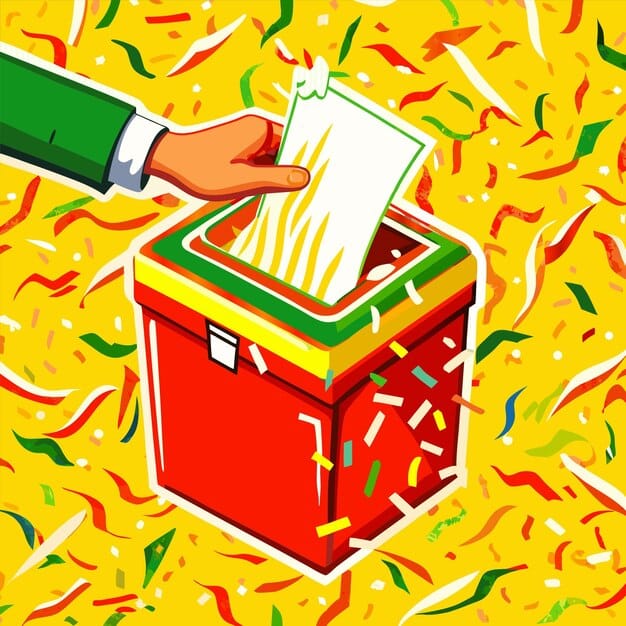Understanding Mexico’s Electoral Reforms: Impact on Democracy

Proposals to fundamentally alter Mexico’s electoral system aim to reduce costs and increase government control over elections, sparking intense debate about potential implications for democratic independence and fair representation.
Understanding the Proposed Changes to Mexico’s Electoral System and Their Impact on Democratic Processes is crucial for anyone following political developments in Latin America. Recent proposals, championed by the current administration, seek to overhaul the independent electoral institutions that have long underpinned Mexico’s transition to a more democratic state. These reform efforts have ignited a fervent national debate, raising fundamental questions about the future of electoral integrity and the balance of power within the country.
The Historical Context of Mexico’s Electoral Institutions
Mexico’s journey toward robust democratic institutions has been arduous, marked by a history of one-party rule and electoral fraud. The creation of independent electoral bodies was a direct response to this past, designed to ensure fairness and transparency where they had previously been absent. Understanding this historical trajectory is essential to grasping the significance of the proposed changes.
For decades, Mexico was dominated by the Institutional Revolutionary Party (PRI). Its long tenure in power was frequently marred by accusations of electoral manipulation, ballot stuffing, and the use of state resources to overwhelmingly favor the ruling party. This era fostered widespread distrust in election outcomes and limited genuine political competition. Citizen movements and opposition parties consistently pushed for reforms that would level the playing field and guarantee impartial oversight.
The Birth of Independent Electoral Bodies
The transformation began in the late 1980s and early 1990s. The Federal Electoral Institute (IFE), later renamed the National Electoral Institute (INE), was established as an autonomous, professional, and independent body. Its mandate was clear: to organize, administer, and oversee federal elections, ensuring their legality, impartiality, objectivity, certainty, and authenticity.
- 1990: Creation of IFE: A crucial step towards disarming the government’s control over elections.
- Autonomy and Impartiality: Designed to remove electoral processes from partisan influence.
- Citizen Participation: Empowering ordinary citizens to serve as poll workers, bolstering trust.
The IFE/INE brought about a new era of trust in Mexican elections. Its transparent processes, strict regulations, and reliance on citizen involvement at every level became benchmarks for electoral integrity in the region. This hard-won independence allowed for a genuine multi-party system to flourish, culminating in the historic presidential election of 2000, which ended 71 years of PRI rule.
The current electoral system, therefore, is not merely a bureaucratic apparatus but a foundational pillar of Mexico’s modern democracy. It represents decades of struggle, compromise, and institutional development aimed at rectifying past injustices and securing legitimate representation for its citizens. Any proposal to alter this system is thus viewed not just as a technical adjustment but as a potential rupture with this democratic legacy.
Key Proposed Reforms: What’s On the Table?
The proposed electoral reforms in Mexico encompass a wide range of changes, from the structure of electoral institutions to the methods of candidate selection and campaign financing. The administration argues these reforms are necessary to cut costs, streamline processes, and eliminate what it perceives as excessive privileges within the current system. Critics, however, contend that the changes are designed to weaken independent oversight and consolidate power.
At the core of the proposals is a plan to significantly restructure the National Electoral Institute (INE). This includes reducing the number of electoral councillors, decreasing its budget, and altering how its members are selected. Currently, INE councillors are nominated by political parties and confirmed by a two-thirds vote in the Chamber of Deputies, a process intended to ensure broad consensus and independence. The proposed reform suggests popular election of these officials, raising concerns about potential politicization.
Reducing the INE’s Scope and Budget
A central tenet of the proposed overhaul is a dramatic reduction in the INE’s budget and operational capacity. The proponents argue that the INE is overly expensive and bloated, consuming too many public resources. This financial squeeze, however, is seen by opponents as a direct attempt to cripple the institution’s ability to effectively organize elections and enforce electoral laws nationwide.
- Budget Cuts: Significant reduction in INE’s annual operational budget.
- Personnel Downsizing: Elimination of thousands of jobs and reduction in local electoral offices.
- Shift to Digital: Increased reliance on digital tools for voter registration and election results, raising cybersecurity concerns for some.
Beyond the INE, the reforms also target state-level electoral bodies, proposing their dissolution and absorption into the federal framework. This centralization of electoral authority would consolidate power in Mexico City, potentially reducing local representation and the ability to tailor electoral processes to regional specificities.
Another significant aspect is the proposed change to the election of legislators. The reform suggests reducing the number of deputies and senators, and electing them through a single national proportional representation list, rather than the current mixed system of individual districts and proportional representation. This would fundamentally alter how political parties structure their campaigns and how citizens interact with their representatives.
Furthermore, campaign finance regulations and access to traditional media for political parties are also subject to proposed changes. While the stated goal is to ensure equity and reduce the influence of money in politics, critics fear these provisions could disproportionately affect smaller parties and favor the incumbent large parties with established media presence.

Arguments For and Against the Reforms
The debate surrounding Mexico’s proposed electoral reforms is deeply polarizing, with fervent arguments put forth by both proponents and opponents. Each side claims to act in the best interest of Mexican democracy, yet their visions for the future of the electoral system diverge sharply.
Proponents, primarily from the ruling Morena party and its allies, emphasize the need for fiscal efficiency and a truly democratic electoral body. Their main arguments center on the perceived excesses and lack of accountability within the current INE.
The Case for Reform: Efficiency and Democracy
The core arguments in favor of the reforms typically focus on several key areas:
- Cost Reduction: The INE is often labeled as an overly expensive institution, with its budget seen as a burden on taxpayers. Proponents argue that significant savings can be achieved by streamlining its operations, reducing personnel, and consolidating some of its functions.
- Democratization of Institutions: The proposal to elect electoral councillors by popular vote is framed as a move to make these officials more accountable to the people rather than to political parties or an elite bureaucracy. This, they argue, would increase trust and legitimacy.
- Eliminating “Excesses” and “Privileges”: Critics of the current system point to high salaries for electoral officials and what they describe as unnecessary expenditures, arguing that the reforms aim to eliminate these “privileges” and ensure public servants live within more reasonable means.
- Strengthening Citizen Participation: Advocates claim that by simplifying the electoral process and reducing its cost, resources can be freed up to enhance direct citizen participation mechanisms, though specific details on this are often vague.
On the other hand, a broad coalition of opposition parties, civil society organizations, academics, and former electoral officials vehemently oppose the reforms. They see the proposals as a direct threat to the autonomy and efficacy of Mexico’s democratic institutions. Their arguments are rooted in concerns about potential backsliding on democratic gains.
The Case Against Reform: Threats to Independence and Stability
Opponents articulate several critical concerns:
- Weakening Electoral Independence: The most significant concern is that the reforms are designed to undermine the INE’s autonomy, making it vulnerable to political interference from the executive branch. Popular election of councillors, they argue, would make them beholden to political movements and personalities rather than legal principles.
- Compromising Electoral Integrity: Significant budget cuts and the reduction of personnel could severely hamstring the INE’s capacity to organize complex elections, ensure accurate voter registries, and vigilantly monitor campaign finance. This raises fears of a return to less transparent and reliable electoral processes.
- Centralization of Power: Dissolving local electoral bodies and centralizing their functions within the federal INE is seen as a move that concentrates power in the hands of the national government, reducing regional inputs and oversight.
- Risk of Democratic Backsliding: Opponents argue that the reforms, if enacted, would dismantle the very institutions that have guaranteed fair elections and peaceful transfers of power for over two decades. This, they warn, could lead to a deterioration of democratic stability and greater political uncertainty.
The debate is therefore not just about technical adjustments but about the fundamental nature of Mexico’s democracy: whether it should consolidate centralized power or continue its trajectory of strong, independent oversight.
Potential Impact on Democratic Processes
The proposed changes to Mexico’s electoral system carry profound implications for the nation’s democratic processes, extending far beyond mere administrative adjustments. Experts and civil society groups warn that these reforms could fundamentally alter the landscape of political competition, potentially affecting everything from voter participation to the legitimacy of future elections.
One of the primary concerns revolves around the independence of the electoral authority. If the INE’s budget is drastically cut, its staff reduced, and its councillors elected through popular vote, its capacity to act as an impartial arbiter could be severely compromised. Elected officials might feel more pressure to align with political factions that supported their campaigns, rather than upholding strict adherence to electoral law and impartiality.
Electoral Integrity and Fairness
The ability of the INE to effectively oversee elections is paramount to maintaining their integrity. Reduced funding could impact the accuracy and timeliness of voter registry updates, lead to fewer polling stations, and limit the capacity for robust monitoring of campaign finance and political advertising. Such limitations could erode public trust in election outcomes, regardless of the actual results.
- Voter Registry Risks: Challenges in maintaining an accurate and up-to-date national voter roll.
- Access to Polling Places: Potential reduction in the number of polling stations, especially in rural or remote areas.
- Campaign Finance Oversight: Diminished capacity to investigate and sanction illegal campaign practices.
The changes proposed for the election of federal legislators, such as shifting to a single national proportional representation list, could also have significant consequences. While potentially simplifying the ballot for some, it could also weaken the direct link between constituents and their representatives. Citizens might feel less connected to a national list of candidates, potentially diminishing accountability at the local level.
Furthermore, independent electoral observation, a cornerstone of transparent elections, could become more challenging. If the INE’s resources are constrained, its ability to facilitate and incorporate the findings of domestic and international observers might be reduced. This could open the door to less scrutiny and more opportunities for irregularities to go unnoticed.
The chilling effect on political pluralism is also a significant concern. Smaller or emerging political parties, which often rely on stringent electoral regulations to ensure a fair playing field against established powers, could find it harder to compete. Any systemic changes that favor larger, incumbent parties, whether intentionally or not, could stifle political diversification and limit the range of choices available to voters.
Ultimately, the discussion around these reforms is a debate about the future quality of Mexico’s democracy. Critics argue that undermining the INE is akin to sawing off the branch one is sitting on, potentially destabilizing the very democratic framework that has been painstakingly built over decades. The consequences could range from increased political polarization to a decline in international confidence in Mexico’s democratic institutions.
Comparative Analysis: Mexico vs. Other Democracies
To fully grasp the implications of Mexico’s proposed electoral reforms, it is useful to place them in a broader international context. Comparing Mexico’s independent electoral body, the INE, with similar institutions in other mature and emerging democracies can highlight what makes the Mexican system unique and what risks these proposed changes might entail.
Most stable democracies worldwide rely on independent electoral commissions or bodies to manage elections. The degree of their autonomy, funding mechanisms, and composition vary greatly, but the underlying principle of impartiality is almost universal. For instance, countries like Canada, Australia, and the United Kingdom have well-established, independent electoral commissions that are typically funded by the state but operate with significant operational autonomy from the executive and legislative branches.
Models of Electoral Administration
Different democracies have adopted various models for administering elections:
- Integrated Model: A single, independent body responsible for all aspects of electoral administration, from voter registration to dispute resolution. (e.g., Mexico’s INE, Brazil’s TSE).
- Decentralized Model: Electoral functions are distributed among various government entities, often with local authorities playing a significant role under federal oversight. (e.g., United States).
- Judicial Model: Electoral disputes and sometimes even administration are heavily influenced or directly managed by the judiciary. (e.g., South Korea, parts of Africa).
The INE, with its broad powers and significant autonomy, generally aligns with the integrated model, often seen in Latin American countries that have transitioned from authoritarian rule. This model was chosen specifically to counteract a history of state interference in elections.
The proposal to elect electoral councillors by popular vote is highly unusual for a major independent electoral body. While some countries elect certain oversight officials, such as auditors, directly, the majority of electoral commission members are appointed through processes designed to prioritize expertise and impartiality, often involving cross-party consensus or judicial review. For example, in India, election commissioners are appointed by the President, typically based on expertise, and enjoy constitutional protection. The politicization of their selection through popular vote could introduce partisan pressures that undermine their impartiality.
Moreover, the proposed budget cuts to the INE stand in contrast to trends in many democracies where electoral bodies are consistently funded to ensure their capacity. Underspending on electoral administration often leads to operational inefficiencies, a decline in voter education programs, and difficulties in implementing new technologies or security measures. International best practices usually advocate for robust and predictable funding to safeguard electoral integrity.
While arguments for cost efficiency are common, the balance between cost and institutional independence is delicate. Many international observers would argue that the cost of maintaining robust, independent electoral institutions is a small price to pay for democratic stability and public trust in election outcomes. Compromising this fundamental structure risks pushing Mexico towards models that have historically struggled with electoral legitimacy, rather than aspiring to the highest standards of democratic practice.

The comparisons underscore that Mexico’s current electoral model, while perhaps imperfect, has largely adhered to international norms for promoting transparent and fair elections. The proposed reforms, particularly those concerning the INE’s autonomy and composition, represent a significant deviation from these established practices and raise legitimate questions about whether Mexico is moving towards, or away from, stronger democratic foundations.
The Role of Civil Society and Public Opinion
In the vibrant democratic landscape of Mexico, civil society plays a crucial role in advocating for democratic principles and holding power accountable. The proposed electoral reforms have ignited a robust response from various segments of society, reflecting deep concerns about the potential consequences for the nation’s democratic future. Public opinion has been a key battleground, with significant mobilization both for and against the proposed changes.
Since the proposals were first introduced, numerous civil society organizations, academic institutions, and citizen collectives have voiced strong opposition. These groups often highlight the historical importance of the INE in establishing electoral transparency and call for the protection of its autonomy.
Citizen Mobilization and Advocacy
The most visible manifestation of public sentiment has been large-scale demonstrations across Mexico. These protests, particularly those organized under the banner of “Don’t Touch My INE” (El INE no se toca), have drawn hundreds of thousands of people to the streets of Mexico City and other major urban centers. These gatherings underscore a significant segment of the population’s commitment to independent electoral institutions.
- Mass Protests: Large-scale demonstrations across the country against the reforms.
- Campaigns on Social Media: Extensive use of platforms to raise awareness and organize dissent.
- Legal Challenges: Civil society groups preparing and filing legal challenges against the constitutional amendments.
Beyond street protests, civil society organizations have engaged in extensive advocacy. This includes issuing public statements, organizing forums and debates, publishing analyses of the proposed changes, and lobbying legislators. Their efforts are aimed at informing the public, pressuring political decision-makers, and reinforcing the message that defending independent electoral bodies is crucial for the health of Mexican democracy.
Public opinion polls on the reforms have shown mixed results, often reflecting the deep political polarization in the country. While some polls indicate a level of support for reducing the cost of elections, they also reveal significant apprehension about weakening the INE’s independence. The narrative put forward by the government often emphasizes efficiency and cost-saving, while opponents stress the importance of protecting democratic oversight, shaping public perceptions differently.
The role of the media, both traditional and social, has been pivotal in shaping this debate. News outlets, political commentators, and social media influencers have provided platforms for both sides, disseminating information and influencing public discourse. The intensity of this media engagement reflects the high stakes involved in the electoral reform discussion.
Looking ahead, the sustained engagement of civil society and the weight of public opinion will likely continue to be determinative factors in the legislative process and any potential legal challenges. The willingness of citizens to defend what they perceive as fundamental democratic gains represents a vital check on governmental power, reinforcing the idea that electoral institutions are not merely state apparatuses but embodiments of collective trust and democratic aspirations.
Future Scenarios and Implications for Mexico’s Democracy
The path forward for Mexico’s electoral system is fraught with uncertainty, and the ultimate outcome of the proposed reforms could set the nation on very different democratic trajectories. Understanding the potential future scenarios and their implications is crucial for assessing the long-term health of Mexican democracy and its relationship with international partners.
One major scenario involves the full passage and implementation of the proposed reforms as currently drafted. If this occurs, it would likely lead to a significantly altered electoral landscape. The National Electoral Institute (INE) would be a different entity, potentially with fewer resources, a more centralized structure, and leadership chosen through popular elections. This could, in the view of critics, lead to:
Potential Outcomes of Reform Implementation
- Heightened Political Polarization: A less independent electoral body might be perceived as biased, intensifying political conflict and public distrust in election results.
- Reduced Electoral Certainty: Questions about the fairness and transparency of elections could resurface, reminiscent of the pre-IFE/INE era, potentially discouraging participation and investment.
- International Scrutiny: Mexico’s democratic credentials could come under closer international scrutiny, possibly affecting diplomatic relations and foreign investment.
Another scenario is that the reforms are watered down, or even rejected, perhaps due to strong opposition from civil society, political parties, or through legal challenges. The widespread public protests against the reforms have already demonstrated the political cost of pushing through highly contested changes. Should the reforms fail, it would signify a victory for those advocating for the preservation of current institutional arrangements. This outcome would likely reinforce the perceived strength of Mexico’s democratic institutions and the capacity of civil society to defend them.
A third, more nuanced scenario, could involve a compromise. Given the political complexities, there might be room for negotiations that result in less drastic changes than initially proposed. This could mean some adjustments aimed at cost-saving but without fundamentally undermining the INE’s autonomy or structural integrity. Such a compromise would require significant political will and a willingness from all sides to find common ground.
The long-term implications for Mexico’s democracy hinge on which of these scenarios unfolds. If the current proposals are fully enacted, the country could face a period of democratic backsliding, where the impartiality of elections is consistently questioned. This could weaken checks and balances, potentially consolidating more power in the executive branch and eroding the foundations of Mexico’s pluralistic political system.
Conversely, if the reforms are successfully resisted or modified, it could strengthen the role of civil society and judicial review in protecting democratic institutions. This would send a strong signal about the resilience of Mexico’s democracy and its commitment to ensuring fair electoral processes, even amidst intense political pressures. The trajectory of Mexico’s electoral system is thus not just a domestic issue but a litmus test for the robustness of democratic governance in a major global player. The choices made today will undoubtedly shape Mexico’s political future for decades to come.
| Key Point | Brief Description |
|---|---|
| 🏛️ INE’s Autonomy | Proposed reforms aim to reduce INE’s independence, funding, and staff, leading to concerns about political interference. |
| 🗳️ Election of Councillors | Shift from legislative appointment to popular election of electoral officials, raising fears of politicization. |
| 💰 Cost Reduction | Proponents advocate for significant budget cuts, while opponents warn of compromised electoral integrity. |
| 📢 Civil Society Response | Widespread public protests and advocacy campaigns against the reforms highlight strong societal opposition. |
Frequently Asked Questions
▼
The INE is Mexico’s autonomous constitutional body responsible for organizing, administering, and overseeing federal, and in some cases, local elections. It maintains the voter registry, delimits electoral districts, regulates campaign finance, and ensures the impartiality and fairness of the electoral process. Established to end government control over elections, it plays a vital role in Mexico’s democratic stability.
▼
The proposed reforms are championed by Mexico’s current presidential administration and its ruling Morena party. The stated motivations include reducing the high costs associated with the electoral system, streamlining bureaucratic processes, and making electoral officials more directly accountable to the public through popular election, aiming to eliminate perceived “privileges.”
▼
Opponents, including civil society groups and opposition parties, primarily fear that the reforms will weaken the INE’s independence and operational capacity. They argue that massive budget cuts, staff reductions, and popular election of councillors could lead to political interference, compromise electoral integrity, and potentially revert Mexico to a less democratic and transparent electoral system.
▼
Mexico’s INE, with its broad autonomy, aligns with the “integrated model” of electoral administration seen in many other democracies that transitioned from authoritarianism. The direct popular election of electoral officials, as proposed, is highly unusual compared to most stable democracies, which typically prioritize non-partisan appointment processes to ensure impartiality and expertise over direct political accountability.
▼
Public opinion has been highly engaged and polarized. Mass protests, particularly under the “Don’t Touch My INE” slogan, have demonstrated strong public opposition to the reforms, emphasizing the value of independent electoral institutions. Civil society organizations have also launched extensive advocacy and informative campaigns, playing a crucial role in shaping the public discourse and lobbying against the proposed changes.
Conclusion
Understanding the Proposed Changes to Mexico’s Electoral System and Their Impact on Democratic Processes is an ongoing and critical exercise. The debate encapsulates Mexico’s struggle to balance fiscal efficiency with the preservation of hard-won democratic institutions. The outcome of these reforms will not only redefine Mexico’s electoral landscape but also signal the government’s commitment to independent oversight and the rule of law. As this political drama unfolds, the vigilance of civil society, the engagement of the citizenry, and the scrutiny of international observers remain paramount to safeguarding the democratic gains achieved over decades of struggle and institutional development.





